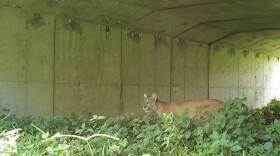On a verdant 9-acre wetland preserve in Sarasota is a school and professional company that attracts ballet talent from around the globe. Dancers come to learn the Cuban technique that founders Ariel Serrano and Wilmian Hernandez studied at the Cuban National Ballet School in Havana. Thirteen years after they opened, Sarasota Cuban Ballet is one of the few Cuban technique training centers in the United States.

Serrano explains how the school got its first big break.
“It was just a place for us to teach our kids,” Serrano said. “After our son and a few, a handful of dancers that we had in that group won the regional YAGP in Atlanta, then lots of kids started to come down here to Sarasota. They heard the story about my son starting at 13, and there he was 15-, 16-year-old winning the competition, and the other two girls that were from different small studios came to us and that took fire, like a wildfire, and a lot of the young dancers from outside the state came, and then from there on it took off.”
The YAGP is the acronym for the Youth American Grand Prix, and Francisco Serrano won a scholarship to train at The Royal Ballet School in London, where he performs as a soloist.

Other Sarasota Cuban Ballet graduates have gone on to secure performance contracts at Miami City, Boston, Washington, Houston and San Francisco Ballet.
All have benefited from the Cuban technique, which traces its lineage to Fernando and Alicia Alonso, who originated the distinctive style to give expression to the Spanish, African and Creole influences predominant in Cuban culture.
“All that comes to classical ballet,” Serrano explained. “How it comes in [is in] the in-between steps, in the contretemps.”
Contretemps is a classical ballet term meaning “beating against time.” A dancer doing a contretemps opens the body to the other side at the last moment.
“The Cuban ballet move[s] you around,” Serrano continued. “It’s not a very straightforward thing. [The dancers] use the whole space. They go one way, change to the other, turn to the other side. The musicality in the classical dance is beautiful because it is a mix of how you perceive all those Latin sounds, all those African sounds and all that they come into the ballet.”
In addition to Caribbean flavor and passion, Cuban technique emphasizes athleticism, turning prowess, balance and partnering.

“The partnering in the Cuban school is very strong,” Serrano observed. “It’s very paternal. We take really good care of that ballerina. It is a trait of our school, as well. Very dynamic. Very athletic. And I think one of the specific things and I think why there is so much balance working the Cuban ballet is because Alicia [Alonso] was really good at balance, and they also throw that in there. And now, one of the things Cuban prima ballerinas are notorious for long balance and very dynamic turns. And the boys as well.”
Now in its 13th season, the Sarasota Cuban Ballet is located at 4740 Cattleman Road in Sarasota.
MORE INFORMATION:
Ariel Serrano and Wilmian Hernandez trained at National Ballet School of Cuba under the direction of Maestro Ramona de Saa, whom Fernando and Alicia Alonso put in charge after they opened their associated professional ballet company.
Serrano and Hernandez moved to Sarasota in 1993. At the time, they were principals with Sarasota Ballet.
They opened Sarasota Cuban Ballet 20 years later.
“The Sarasota Cuban Ballet was my wife’s idea,” Serrano acknowledged. “She wanted to start a school because our son and our daughter, in 2013, were starting ballet. But back then, there was nothing here in Sarasota. So she said why don’t we open a ballet studio with our technique and teach our kids, and hopefully some other dancers will come. And so it happened.”
Serrano is quick to point out that as National Ballet School of Cuba graduates, he and his wife were fully accredited to teach ballet.
“When you graduate from the national school in Cuba, it’s not only as a dancer, but it also gives you the teaching courses. So when we came out, we were ready to teach all dance.”
A year later, the school took flight after Serrano and Hernandez’s son, Francisco, won the Youth American Grand Prix and a scholarship to train at The Royal Ballet School.

Today, Serrano’s daughter and nephew teach at Sarasota Ballet. Francisco helps out during visits, but trains and performs as a soloist with The Royal Ballet in London.
“He joined The Royal Ballet’s Aud Jebsen Young Dancers Programme at the start of the 2016/17 season and entered the company as an Artist at the start of the 2017/18 season, promoted to first artist in 2023 and soloist in 2024. He trained at The Royal Ballet Upper School,” states Francisco’s Royal Ballet profile. “Performances while at the School include Solo (Waltz and Pas d’action from La Bayadère) and in Frederick Ashton’s Rhapsody pas de deux and Kenneth MacMillan’s Soirées musicales at the annual matinees, and with The Royal Ballet in The Nutcracker and Frankenstein. Serrano’s awards include second prize in the 2015 Lynn Seymour Award for Expressive Dance. His repertory with the Company includes Drum Major (Different Drummer), Spanish (Swan Lake, The Nutcracker), Mercutio (Romeo and Juliet) and roles in Light of Passage, Infra, Medusa, Symphonic Dances, Solo Echo, Anemoi and Flight Pattern.”
Sarasota Cuban Ballet continues to celebrate and sustain the cultural legacy of the Cuban technique through education, performance and community outreach.

While the Cuban technique gives expression to the influence of the Spanish, African and Creole cultures prevalent in Cuba, Fernando and Alicia Alonso gave careful consideration to ballet’s European tradition and the influence of its Russian, French and British origins before evolving their own distinctive style.
“Before they opened their company, they went to the bigger houses in Europe, to all the big companies, and observed how these companies were working and training their students,” Serrano explained. “They came back to Cuba with the idea we are obviously not Europeans. We are a very mixed community. How can we make this work for our people? And that’s how the ballet school and the Cuban technique was created.”
While the steps may be the same, dancers trained in Cuban technique are more “pulled in” when they perform those steps. “They hold the positions higher [than their European counterparts].
The Cuban technique is still evolving.
“I went to Cuba in 2013 when I first opened the school and I could not believe the development of the [National Ballet School],” Serrano noted. “In my young days, 1983, ‘84, we were holding two hands on the bar, we were doing lots of balance, not truly pushing forward. When I went back in 2013, kids 12, 13 years old, they were already turning … not very clean, not very aesthetically beautiful … but already doing turns. And said to my old teacher, ‘Wait, wait, what’s going on? How is it that these kids are doing these steps that they’re not even ready for?’ And she’s ‘Well, we keep evolving. With you guys we learned that you took longer to find and master these steps. With these guys, we’re throwing them in there and by the time they’re 15, we clean them and they’re already done.’ And it hits me like a brick. Oh Jesus, it took so long for me to lose the fear of turning, because I started turning later in the air. That was very scary, you know, turning in the air and getting spun around. And right there it was, these young kids turning all crooked, and landing.”
The pace of this evolution became even clearer for Serrano and his wife when, a few years later, they brought some of those young dancer to America.
“They were amazing, amazing dancers,” said Serrano reverently. “And so with that, I tell you that the school evolved and is in constant movement and working for what the body needs in the best way possible.”
Support for WGCU’s arts & culture reporting comes from the Estate of Myra Janco Daniels, the Charles M. and Joan R. Taylor Foundation, and Naomi Bloom in loving memory of her husband, Ron Wallace







